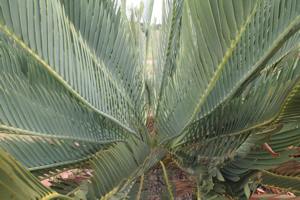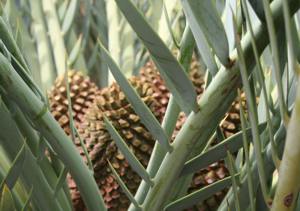Encephalartos middelburgensis
Encephalartos middelburgensis Vorster, Robbertse & S.van der Westh.
Family: Zamiaceae
Common names: Middelburg cycad (Eng.)
SA Tree No: 14.3
Introduction
Encephalartos middelburgensis is a blue-leaved cycad covered with persistent powdery bloom. It thrives in full sunlight and is frost-hardy. It is distinguished within the group of blue-leaved species of northern South Africa by its long, straight leaves with terminal part curving very slightly upwards, with entire leaflets and reddish brown cones with fine brown hairs.

Description
Description
Encephalartos middelburgensis is a large cycad, with an aerially unbranched, erect stem which tends to recline when long, growing in clumps of up to twelve stems and producing suckers freely from the base; the stem grows up to 7m tall with a diameter of 250-400 mm; the stem apex is characterised by inconspicuous, long and slender cataphylls (scale leaves).
The leaves are stiff, attain a length of 1.0-1.5 m, bluish-green, straight, with the apex tending to curve very slightly upwards, with persistent powdery bloom and with the same colour on both upper and lower side. Young leaves are often silvery due to a dense covering of powdery bloom. Leaflets tend to shield one another downwards but only at the leaf apex; median leaflets are leathery and without nodules, 180-190 mm long and 14-19 mm broad. The margin of the lower leaflets tends to curve upwards while that of the upper ones tends to curve downwards; the basal leaflets decrease in size, usually to one or two spines. The petiole (leaf stalk) is triangular and 100-200 mm long.

Male and female plants bear 4-8 reddish brown cones per season per stem. Male cones attain a length of up to 450-700 mm and a diameter of 85-130 mm, having a stalk up to 50-170 mm long. Female cones attain a length of up to 350-450 mm and a diameter of 170-200 mm, with a stalk up to 150 mm long which is usually obscured largely by the cataphylls of the stem. Cones of Encephalartos middelburgensis do not disintegrate spontaneously as those of the other species do, but dry out during September-October to yield 170-260 detached seeds. Seeds are yellow to light brown, with a length of 38-40 mm and a diameter of 22-24 mm.

Conservation Status
Status
According to Raimondo et al. (2009), E. middelburgensis is critically endangered (CR), as the best available evidence indicates that it meets all five IUCN criteria for critically endangered, and is therefore facing an extremely high risk of extinction in the wild.
Distribution and habitat
Distribution description
The Middelburg cycad occurs in Mpumalanga, in the upper catchment area of the Olifants River between Middelburg and Loskop Dam. It grows in open grassy, rocky areas on steep slopes on slightly acidic soils at between 1000-1400 m altitude above sea level. The annual rainfall in its distribution area is 600 mm and occurs predominantly in summer. The climate in the area is hot in summer and cold in winter. E. middelburgensis grows well in full sunlight and is frost-hardy.

Derivation of name and historical aspects
History
This species was published in 1989 by P.J. (Hannes) Robbertse, Pieter J. Vorster and Suzelle van der Westhuizen, after John J. Lavranos and Douglas L. Goode had described it during the previous year as Encephalartos eugene-maraisii subsp. middelburgensis. The epithet refers to Middelburg District in which the species mainly occurs.
Ecology
Ecology
Encephalartos species are pollinated by insects and wind in the wild, but it is advisable to use hand pollination in the garden for better results.
The fleshy outer covering layer of the seeds is desirable food for a range of animals such as monkeys, birds, rodents and bats. Therefore, with any luck, the seeds are discarded some distance away from the parent plant in a hospitable environment in which they are likely to germinate.

Uses
Use
Cycads can be used as attractive decorative or focal point plants in gardens, and can also be very effective as grouped plantings with some succulents.
Growing Encephalartos middelburgensis
Grow
Encephalartos midddelburgensis is easily propagated from seeds and suckers (the young plants that grow around the main stem). Seedlings at the one-leaf stage are susceptible to the fungal disease "damping off" which kills the seedling's single leaf at ground level.
The seeds should be collected, cleaned and stored in a brown paper bag at 10-15 ºC for six months or more, to allow the embryo to fully develop. The seeds are cleaned to ensure that all the flesh is removed since it may contain germination inhibitors and can also promote the growth of fungi. The flesh is scraped away with a knife. Protective gloves should be worn during the cleaning operation to prevent contact with the slow-acting poisons present in the flesh. If the flesh is hard and dry, it helps to soak the seeds in water for a day or two before cleaning. Even if the seeds have been cleaned, it is a good idea to soak them for a few days, preferably with daily changes of water, before planting them. When the seeds are placed in water, the viable ones will sink and the non-viable ones will float.
To germinate the seeds, place the cleaned seeds on their sides half buried on washed sand or potting mix, and keep at about 28 ºC. It is necessary to keep the medium moist, but not too wet, for as long as it takes for germination to take place. As soon as the radicals of the sprouted kernels are 10-20 mm long, they can be planted singly in plastic bags containing potting soil or some other suitable medium. Alternatively, one can wait until the seedlings develop one or two leaves before transplanting them individually into bags.
Because cycad seedlings form long tap roots, it is advisable to use tall narrow perforated black plastic bags about 24 x12 cm in size for their initial establishment. Place the seedlings under shade for the first few years of growth and development. Initially the seedlings must be watered daily with a fine spray. After about a month, as their roots elongate, the frequency of watering should be decreased to once a week. The seedlings can be transplanted into the garden when they are 3-5 years old.
When preparing to propagate from suckers, a hole should be dug around the stem of the mother plant to expose the base and roots of the suckers. One must use a clean sharp knife or sharp spade to remove the sucker from the mother plant. The wound should then be treated with flowers of sulphur or a fungicide such as Benlate or Kaptan and dried for about a week before planting the sucker into a sterile medium.
Cycads are ideal for a low maintenance garden, as they require a minimum of water and are undemanding in their soil and environmental needs.
Pests troublesome to cycads are scale insects, beetles and chewing insects. Scale insects cause great damage to cycad leaves by sucking the sap from them. Most scale insects can be controlled with regular and frequent applications of horticultural soluble oil such as white oil. Beetles seriously damage cycad plants by attacking the emerging young leaves. Control can be kept by application of contact or systemic insecticides, or one of the bacterial preparations available.
Everyone who is in possession of cycads must have a permit. Please contact your provincial nature conservation authority for details
References
- Barkhuizen, B.P. 1975. The cycad garden of UNISA. UNISA Press, Pretoria.
- Giddy, C. 1974. Cycads of South Africa . Struik, Cape Town.
- Grobbelaar, N. 2002. Cycads of Southern Africa. Author, Pretoria.
- Jones, D.L. 1993. Cycads of the world : Ancient plants in today's landscape. Reed, New South Wales.
- Raimondo, D., Von Staden, L., Foden, W., Victor, J.E., Helme, N.A., Turner, R.C., Kamundi, D.A. & Manyama, P.A. (eds). 2009. Red List of South African plants 2009. Strelitzia 25. South African National Biodiversity Institute, Pretoria.
Credits
William Khutso Sepheka
Pretoria National Herbarium
July 2013
Plant Attributes:
Plant Type: Tree
SA Distribution: Mpumalanga
Soil type: Loam
Flowering season:
PH: Acid
Flower colour:
Aspect: Full Sun
Gardening skill: Easy
Special Features:
Horticultural zones











Rate this article
Article well written and informative
Rate this plant
Is this an interesting plant?
Login to add your Comment
Back to topNot registered yet? Click here to register.